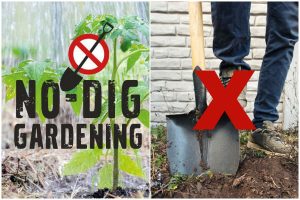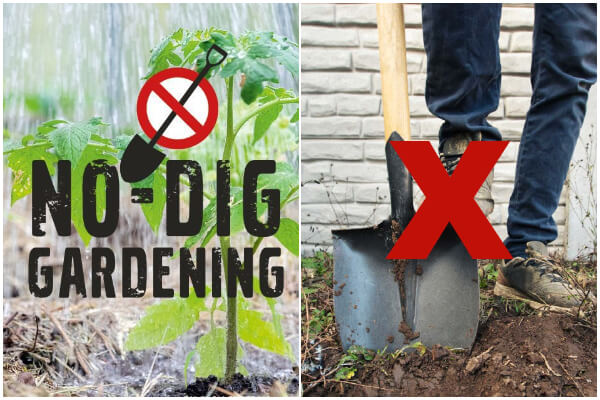Gardening enthusiasts are often encouraged to till or dig their soil as part of traditional garden preparation. However, the no-dig gardening method is gaining traction as a sustainable and eco-friendly alternative. This approach not only protects the soil but also saves time, reduces labor, and enhances plant growth. In this article, we’ll explore the numerous benefits of no-dig gardening and provide practical steps to implement this method in your own space.

1. Preserving Soil Structure
The structure of soil plays a vital role in supporting plant health. Soil is naturally layered, with an intricate network of pores that facilitate the movement of air, water, and nutrients. Digging disrupts this natural structure, leading to compaction, reduced aeration, and poor drainage.
No-dig gardening avoids such disturbances, maintaining the soil’s natural integrity. Roots can penetrate more easily, and water retention improves, creating an ideal environment for plant growth.
- Use a thick layer of mulch or compost to protect the soil surface from erosion and compaction caused by heavy rainfall.
2. Enhancing Soil Health
Beneath the surface, the soil teems with life—microorganisms, fungi, and earthworms form a complex ecosystem that contributes to plant vitality. When you dig or till the soil, you destroy this delicate ecosystem. Beneficial fungi, like mycorrhizae, which form symbiotic relationships with plant roots, are especially vulnerable to disturbance.
By adopting no-dig methods, you allow these organisms to thrive. Healthy, undisturbed soil becomes more fertile over time, reducing the need for chemical fertilizers and amendments.
- Healthy soil microorganisms improve nutrient cycling and disease resistance in plants.
- Earthworms aerate the soil naturally, enhancing its structure and fertility.
3. Reducing Weed Growth
One of the most frustrating aspects of gardening is dealing with weeds. When you dig or till, you inadvertently bring dormant weed seeds to the surface, exposing them to sunlight and triggering germination.
In no-dig gardening, weed seeds remain buried and inactive. A thick layer of organic mulch further suppresses weed growth by blocking sunlight. Over time, this results in fewer weeds and reduced maintenance.
- Use natural weed barriers, such as cardboard or newspaper, beneath your mulch to provide an additional layer of protection.
4. Preventing Soil Erosion
Soil erosion is a common problem in gardens that rely on traditional tilling methods. Exposed soil is vulnerable to being washed away by rain or blown away by wind, leading to the loss of valuable nutrients.
The no-dig approach emphasizes keeping the soil covered, whether with organic mulch, compost, or living plants. This not only prevents erosion but also helps retain moisture and reduce nutrient runoff.
- Farmers using no-till methods have reported improved topsoil quality and reduced erosion compared to conventional farming techniques.
5. Saving Time and Energy
Gardening should be enjoyable, not exhausting. Digging and tilling are labor-intensive tasks that require significant time and effort. The no-dig method eliminates these steps, allowing gardeners to focus their energy on planting, watering, and harvesting.
- Less physical strain, making gardening accessible to people of all ages and abilities.
- Faster garden setup, especially when using raised beds or containers.
6. Supporting Sustainable Gardening Practices
In an era where sustainability is a priority, no-dig gardening offers an eco-friendly solution. By reducing the need for heavy machinery and fossil fuels, this method helps lower your garden’s carbon footprint. Additionally, the use of organic mulches and compost aligns with principles of organic and regenerative agriculture.
- Reduces greenhouse gas emissions associated with mechanical tilling.
- Promotes biodiversity by preserving soil life.
How to Start Your No-Dig Garden
Starting a no-dig garden is a straightforward and rewarding process that allows you to cultivate healthy plants while preserving soil integrity. This method is not only easy to implement but also sustainable and perfect for gardeners of all experience levels. Below is a detailed step-by-step guide to help you transition to a no-dig garden seamlessly.
- Choose the Right Location
The first and most crucial step in setting up your no-dig garden is selecting the perfect location. Look for a spot that receives ample sunlight throughout the day, as most vegetables, flowers, and herbs thrive in sunny conditions. If the area is currently covered with grass, weeds, or other vegetation, don’t worry—this can be managed easily. Cover the area with a thick layer of cardboard or several sheets of newspaper. These materials act as a natural weed barrier by smothering unwanted growth and preventing light from reaching the weeds or grass. Over time, they will decompose and enrich the soil below.
- Build a Fertile Foundation with Organic Matter
Once your location is prepped, it’s time to layer the foundation of your no-dig garden with rich organic matter. Organic materials like compost, well-rotted manure, or leaf mold are ideal for creating a nutrient-dense base that will support healthy plant growth. Spread the organic matter evenly over the soil or the cardboard layer to a depth of at least 4–6 inches. This layer will act as a growing medium and provide essential nutrients to your plants while improving soil structure over time.
For best results, ensure that the organic matter is well-decomposed. This allows plant roots to establish quickly and reduces the risk of introducing weed seeds or pathogens into your garden.
- Add a Protective Mulch Layer
To protect the organic matter and further optimize your no-dig garden, apply a thick layer of mulch over the compost. Materials such as straw, shredded leaves, wood chips, or grass clippings are excellent choices. Mulch serves multiple purposes: it suppresses weed growth by blocking sunlight, retains moisture to reduce watering needs, and helps regulate soil temperature, keeping it cool in summer and insulated during colder months.
Be sure to replenish the mulch layer as it decomposes over time, ensuring continuous protection and soil enrichment.
- Plant Seeds or Seedlings Directly
Now comes the exciting part—planting! In a no-dig garden, you can plant seeds or seedlings directly into the compost layer. To plant seeds, create small holes or furrows in the compost and sow them at the recommended depth for each plant. For seedlings, dig small planting holes just deep enough to accommodate their roots.
As the plants grow, their roots will naturally penetrate through the compost into the undisturbed soil beneath, accessing additional nutrients and moisture. This process allows for strong root development and minimizes plant stress.
- Maintain and Nourish Your Garden
A no-dig garden is low-maintenance, but regular care is essential to keep it thriving. Each year, refresh the compost layer by adding 2–3 inches of fresh organic matter to replenish nutrients. Similarly, check the mulch layer and add more as needed to maintain weed suppression and moisture retention.
Additionally, monitor your plants for signs of pests or diseases and address issues promptly. Since the no-dig method supports a healthy soil ecosystem, your plants will naturally be more resilient to many common problems.
Transitioning to a no-dig gardening method offers countless benefits, from reducing labor and improving soil health to creating a thriving ecosystem for plants and beneficial organisms. By following these simple steps, you can set up a productive, sustainable garden that saves time and effort while delivering abundant harvests year after year.
Whether you’re an experienced gardener or a beginner looking for an eco-friendly way to grow plants, the no-dig method is a game-changer. Start your no-dig garden today and enjoy the rewards of healthier soil, fewer weeds, and a more enjoyable gardening experience.
Common Misconceptions About No-Dig Gardening
- It’s Only for Small Gardens
No-dig gardening can be scaled up for larger spaces, including farms. Many commercial growers successfully use no-till methods.
- It Doesn’t Work in Clay Soils
While clay soils can be challenging, the addition of organic matter over time improves their texture and drainage, making no-dig gardening feasible.
- It’s Expensive
While there may be an initial investment in compost or mulch, the long-term savings on fertilizers, tools, and labor outweigh the costs.
No-dig gardening isn’t just a trend—it’s a proven method that promotes healthier plants, better yields, and a more sustainable future. By preserving soil structure, enhancing soil health, and reducing labor, this approach makes gardening accessible and enjoyable for everyone.
Start your no-dig journey today, and experience the difference it can make in your garden and the environment.

